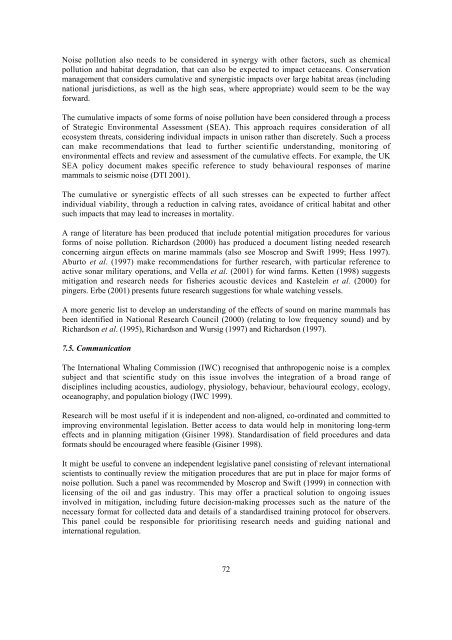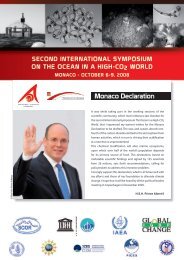acoustic measurements have been made on a few str<strong>and</strong>ed or rehabilitated cetaceans (Ridgeway<strong>and</strong> Carder 2001).Caution should be encouraged in the use <strong>of</strong> captive or str<strong>and</strong>ed (<strong>and</strong> therefore compromised)animals to obtain data.7.2.5. S<strong>of</strong>tware modelsComputational models <strong>of</strong> whale auditory sensitivities, such as the humpback whale hearingmodel (Helweg et al. 2000) may be <strong>of</strong> assistance in determining cetacean sensitivity to sound.S<strong>of</strong>tware models to estimate the potential effects <strong>of</strong> <strong>noise</strong> impacts have proved valuable for whalewatching (Erbe <strong>and</strong> Farmer 2000).A spatial model <strong>of</strong> collision risk has been developed (Tregenza et al. 2000). This model hasidentified that mitigation procedures are urgently required. For example, the model indicates thata population <strong>of</strong> short finned pilot whales <strong>of</strong>f the Canary Isl<strong>and</strong>s is at risk <strong>of</strong> extinction fromcollisions, unless consistent <strong>and</strong> effective mitigation action is carried out.Autopsied animals, <strong>and</strong> computational studies that do not require the use <strong>of</strong> trained or wildcetaceans, should be used wherever possible to obtain auditory data. Correlational studies, such ascorrelations <strong>of</strong> str<strong>and</strong>ings with increases in <strong>noise</strong> levels or military manoeuvres, are generallypreferred to experimental ones (Whitehead <strong>and</strong> Weilgart 2001).7.3. Long-term impactsHESS (1997) stated that behavioural effects <strong>of</strong> concern related to feeding, social behaviour,migration, avoidance <strong>and</strong> ab<strong>and</strong>onment <strong>of</strong> critical habitat. Changes in these behaviours could have aneffect that could impact a population over the longer term. It generally remains difficult to detectthese changes <strong>and</strong> therefore designation <strong>of</strong> certain critical areas as sacrosanct is urgently required.Unlike l<strong>and</strong>-based critical habitat, marine critical habitat is likely to be less fixed. Thus, it may benecessary to adjust the boundaries or zones over time as, for example, cetacean distributions changewith oceanic conditions. With larger overall protection areas, it can be easier to adjust or move theboundaries <strong>of</strong> the core reserve or critical habitat zones. One precautionary tool is the marineprotected area, where core components <strong>of</strong> highly protected areas should ideally be nested within anetwork <strong>of</strong> multi-zone areas.There has been an increase in the number <strong>of</strong> forums held specifically for discussion <strong>of</strong> <strong>noise</strong>impacts to cetaceans <strong>and</strong> suitable mitigation procedures in recent years. The majority <strong>of</strong> theseforums have been focused on activities that propagate over large ocean areas, for example,seismic activities (see HESS 1997; etc) <strong>and</strong> even outside the dominion <strong>of</strong> national EEZs, as is thecase for some military activities (see Gisiner 1998). Other forums have looked more generally atthe issue <strong>of</strong> <strong>noise</strong> pollution <strong>and</strong> cetaceans (see, for example, NZ 1996; JASA 2001; 2000).7.4. Cumulative impactsThe cumulative impacts <strong>of</strong> <strong>noise</strong> pollution should be considered alongside individual mitigationmeasures for a particular activity, or part <strong>of</strong> that activity. For example, there are <strong>of</strong>ten rules forwhale watch vessels, limiting the number <strong>of</strong> vessels at one time, <strong>and</strong> designating a larger distance<strong>of</strong> protection around the animals as the number <strong>of</strong> vessels increases (see Annex 2A for anexample <strong>of</strong> detailed whale watching guidelines).71
Noise pollution also needs to be considered in synergy with other factors, such as chemicalpollution <strong>and</strong> habitat degradation, that can also be expected to impact cetaceans. <strong>Conservation</strong>management that considers cumulative <strong>and</strong> synergistic impacts over large habitat areas (includingnational jurisdictions, as well as the high seas, where appropriate) would seem to be the wayforward.The cumulative impacts <strong>of</strong> some forms <strong>of</strong> <strong>noise</strong> pollution have been considered through a process<strong>of</strong> Strategic Environmental Assessment (SEA). This approach requires consideration <strong>of</strong> allecosystem threats, considering individual impacts in unison rather than discretely. Such a processcan make recommendations that lead to further scientific underst<strong>and</strong>ing, monitoring <strong>of</strong>environmental effects <strong>and</strong> review <strong>and</strong> assessment <strong>of</strong> the cumulative effects. For example, the UKSEA policy document makes specific reference to study behavioural responses <strong>of</strong> marinemammals to seismic <strong>noise</strong> (DTI 2001).The cumulative or synergistic effects <strong>of</strong> all such stresses can be expected to further affectindividual viability, through a reduction in calving rates, avoidance <strong>of</strong> critical habitat <strong>and</strong> othersuch impacts that may lead to increases in mortality.A range <strong>of</strong> literature has been produced that include potential mitigation procedures for variousforms <strong>of</strong> <strong>noise</strong> pollution. Richardson (2000) has produced a document listing needed researchconcerning airgun effects on marine mammals (also see Moscrop <strong>and</strong> Swift 1999; Hess 1997).Aburto et al. (1997) make recommendations for further research, with particular reference toactive sonar military operations, <strong>and</strong> Vella et al. (2001) for wind farms. Ketten (1998) suggestsmitigation <strong>and</strong> research needs for fisheries acoustic devices <strong>and</strong> Kastelein et al. (2000) forpingers. Erbe (2001) presents future research suggestions for whale watching vessels.A more generic list to develop an underst<strong>and</strong>ing <strong>of</strong> the effects <strong>of</strong> sound on marine mammals hasbeen identified in National Research Council (2000) (relating to low frequency sound) <strong>and</strong> byRichardson et al. (1995), Richardson <strong>and</strong> Wursig (1997) <strong>and</strong> Richardson (1997).7.5. CommunicationThe International Whaling Commission (IWC) recognised that anthropogenic <strong>noise</strong> is a complexsubject <strong>and</strong> that scientific study on this issue involves the integration <strong>of</strong> a broad range <strong>of</strong>disciplines including acoustics, audiology, physiology, behaviour, behavioural ecology, ecology,oceanography, <strong>and</strong> population biology (IWC 1999).Research will be most useful if it is independent <strong>and</strong> non-aligned, co-ordinated <strong>and</strong> committed toimproving environmental legislation. Better access to data would help in monitoring long-termeffects <strong>and</strong> in planning mitigation (Gisiner 1998). St<strong>and</strong>ardisation <strong>of</strong> field procedures <strong>and</strong> dataformats should be encouraged where feasible (Gisiner 1998).It might be useful to convene an independent legislative panel consisting <strong>of</strong> relevant internationalscientists to continually review the mitigation procedures that are put in place for major forms <strong>of</strong><strong>noise</strong> pollution. Such a panel was recommended by Moscrop <strong>and</strong> Swift (1999) in connection withlicensing <strong>of</strong> the oil <strong>and</strong> gas industry. This may <strong>of</strong>fer a practical solution to ongoing issuesinvolved in mitigation, including future decision-making processes such as the nature <strong>of</strong> thenecessary format for collected data <strong>and</strong> details <strong>of</strong> a st<strong>and</strong>ardised training protocol for observers.This panel could be responsible for prioritising research needs <strong>and</strong> guiding national <strong>and</strong>international regulation.72
- Page 2:
Oceans of Noise 2004A WDCS Science
- Page 8 and 9:
In the US, the deployment of Low Fr
- Page 10 and 11:
its propagation beyond those declar
- Page 12 and 13:
The best evidence for noise being f
- Page 14 and 15:
Box 1. Characteristics of sound / l
- Page 16 and 17:
Sound speed (c)The speed (c) of a w
- Page 18 and 19:
Box 2. The effects of temperature,
- Page 20 and 21:
2.1.2. Measuring sound intensityIde
- Page 22 and 23: i.e. Equal pressure measurements di
- Page 24 and 25: Spherical or Geometrical spreading
- Page 28 and 29: 5.0 145Tug pulling loaded barge 1.0
- Page 30 and 31: The source used during 3-D surveys
- Page 32 and 33: Machinery noisePropulsion machinery
- Page 34 and 35: Man-made islands /caissonsFixed pla
- Page 36 and 37: 12 3245Drill bit6Figure 3.4. Sound
- Page 38 and 39: Transientnoise sourcesAircraftHelic
- Page 40 and 41: Results from the aerial surveys con
- Page 42 and 43: haemorrhaging in the inner ears and
- Page 44 and 45: However they also noted that whales
- Page 46 and 47: 4. The Use of Sound by CetaceansChr
- Page 48 and 49: seems logical, therefore, that if t
- Page 50 and 51: However, despite the reported low a
- Page 52 and 53: Kamminga and Wiersma 1981;Akamatsu
- Page 54 and 55: SongSocial callsShrieksSlaps0.03-80
- Page 56 and 57: anthropogenic factors that make the
- Page 58 and 59: 5.3 Longer-term impactsNoise is cle
- Page 60 and 61: 5.4 Indirect impactsThe above impac
- Page 62 and 63: decompression sickness (DCS) as see
- Page 64 and 65: 6. Examples of regional and nationa
- Page 66 and 67: 6.3 ASCOBANS and ACCOBAMSTwo region
- Page 68 and 69: implications and the discussion sho
- Page 70 and 71: 7.1. Consideration of Voluntary vs.
- Page 74 and 75: 7.6. Methods of protectionComplianc
- Page 76 and 77: 7.6.1 Monitoring7.6.1.1 Visual, aco
- Page 78 and 79: Delory et al. (2002) use Ambient No
- Page 80 and 81: 8. ReferencesAburto, A., Rountry, D
- Page 82 and 83: Caldwell, M.C., Caldwell, D.K., and
- Page 84 and 85: Engas, A., Lokkeborg, S., Ona, E. a
- Page 86 and 87: IWC 2002b. Report of the Scientific
- Page 88 and 89: McCauley, R.D. 1994. Seismic Survey
- Page 90 and 91: Potter, J. and Delory, E. 2001. Noi
- Page 92 and 93: Smolker, R.A., Mann, J. and Smuts,
- Page 94 and 95: Watkins, W.A. 1981b. The activities
- Page 96 and 97: ANNEX 1The Application of Marine Po
- Page 98 and 99: an important factor. 13 The judgeme
- Page 100 and 101: in the preparatory work of the LOSC
- Page 102 and 103: practice by the UNEP Governing Coun
- Page 104 and 105: protection and preservation of the
- Page 106 and 107: than international rules, standards
- Page 108 and 109: Four of the twelve regional seas tr
- Page 110 and 111: seismic operations in the Protocol
- Page 112 and 113: ConclusionAt the global level, only
- Page 114 and 115: Art 209 LOSC focuses on both standa
- Page 116 and 117: No State Party may impose condition
- Page 118 and 119: coastal States”. This formulation
- Page 120 and 121: If the IMO makes this determination
- Page 122 and 123:
estrictions to vessels operating in
- Page 124 and 125:
In the EEZ, in comparison to the te
- Page 126 and 127:
Appendix A - Some international ins
- Page 128 and 129:
Convention for the Protection of th
- Page 130 and 131:
Available at:http://www.unep.ch/sea
- Page 132 and 133:
BucharestConventionArticle XIPollut
- Page 134 and 135:
environment1. The Contracting Parti
- Page 136 and 137:
- that under Article III.8.c) of AC
- Page 138 and 139:
e) no sudden or repeated change in
- Page 140 and 141:
Ref: Nowacek et al. 2001.Location:
- Page 142 and 143:
Location: Arctic• Vocal behaviour
- Page 144 and 145:
• Vaquita surfacing duration and
- Page 146 and 147:
• 6% of small delphinids (n=264;
- Page 148 and 149:
Species type: Boto, Inia geoffrensi
- Page 150 and 151:
• Humpback whales appeared tolera
- Page 152 and 153:
• Behaviour interpreted as aggres
- Page 154 and 155:
• There was no evidence of minke
- Page 156 and 157:
• Northern right whales may be ap
- Page 158 and 159:
• Migrating gray whales disturbed
- Page 160 and 161:
to Ensenada De La Paz, Mexico. Aqua
- Page 162 and 163:
distribution of humpback whales, Me
- Page 164 and 165:
Richardson, C.R. Greene, C.I. Malme
- Page 166 and 167:
Zhou, K., Pilleri, G. and Li, Y. 19
- Page 168 and 169:
6. surveys for Cuvier’s beaked wh




